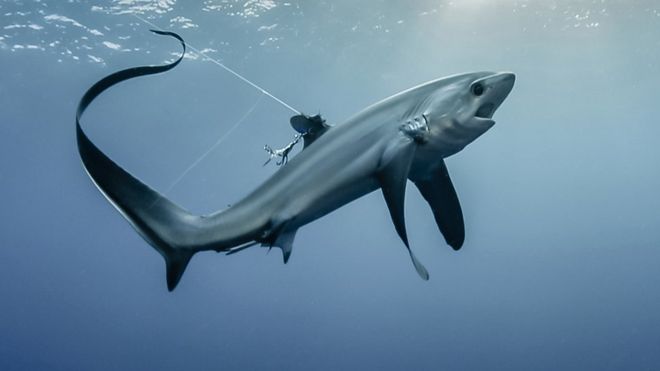Known for its long whip-like tail, the threatened Thresher shark is among a number of marine species given extra protection at the Cites meeting.
Devil rays and Silky sharks have also been given additional safeguards, according to BBC.
These shark species have seen huge population falls over the past decades, due to the demands of the shark fin trade.
Devil rays are valued for the gill plates which are used in Chinese medicine.
Campaigners believe the safeguards under Cites will make a real difference to these species survival.
Few sharks protected
It’s estimated that around 100 million sharks of all types are killed in commercial fisheries – with their fins often destined for markets in China and Hong Kong.
Despite the scale of the fishing, there are just eight species given some protection under the Convention on International Trade in Endangered Species (Cites).
Now the silky and thresher sharks have also acquired this same level of protection.
Thresher sharks are at the highest risk of extinction among all pelagic sharks and are described as vulnerable by the IUCN.
“These are incredible animals, with their long whip like tails they’re referred to as the Indiana Jones of the sea,” said Luke Warwick with Pew Charitable Trusts.
“They stun the fish with their tails and can pick them up easily. These are species that divers want to see but they are being driven to extinction by unsustainable trade.
“Cites now has a chance to stop that because if countries want to continue to trade thresher shark fins they will have to make sure those fisheries are sustainable.”
Smooth operator
Silky sharks, named for the smooth texture of their skin, are found all around the world in warmer, tropical waters. In much of the Atlantic and Pacific Ocean their populations are decreasing, with estimates of a 70% reduction in numbers in almost every area where these sharks are found.
The silky is known for its strong sense of hearing which helps it to hunt tuna, octopus and squid – However this taste for tuna often causes their demise, as they chase their prey at speed and don’t see fishing nets until it is too late.
Devil rays, also known as mobula rays, can jump from the water and reach heights of up to 2 metres, staying airborne for several seconds. But these flat fliers are also deep divers. Experts say they can go down to around 2km below the surface for 60-90 minutes.
One big vulnerability for devil rays is their tendency to aggregate in large numbers, making them very easy prey for targeted fishing.
What’s driving the market for these large brained curious creatures is traditional Chinese medicine. The dried gill plates are used in a soup that’s supposed to treat fever and help nursing mothers.
H.Z

